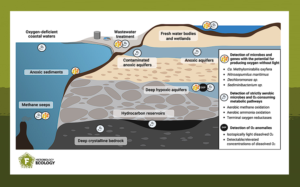Microbes have the astonishing ability to use a broad spectrum of energy and carbon sources. That’s why they can colonize even the most extreme habitats on Earth, from sulfidic lagoons to the deep biosphere. The minireview “Widespread occurrence of dissolved oxygen anomalies, aerobic microbes, and oxygen-producing metabolic pathways in apparently anoxic environments” in FEMS Microbiology Ecology discusses the process of dark oxygen production in apparently anoxic environments with far-reaching implications as explained by Emeline Vidal and Laura Schwab. #FascinatingMicrobes
No oxygen, no problem – but…
Just like us, many microbes use molecular oxygen (O2) to gain energy since oxygen respiration yields more energy than almost any other metabolism. That’s why, when available, oxygen is rapidly consumed.
Many habitats, especially in the subsurface or in water bodies, are thus free of dissolved oxygen. So, microbes residing in these environments respire other compounds, like sulfate, nitrate, or iron; or they gain energy via fermentation.
These anaerobic metabolic pathways are widespread but generally yield less energy than aerobic respiration. However, some microbes produce their own oxygen in environments where oxygen is otherwise not available.
Producing oxygen – more than one way of doing it
Nearly all molecular oxygen on Earth is produced via oxygenic photosynthesis by plants or photosynthetically active microorganisms. In contrast, the light-independent dark oxygen production has been thought to be negligible for the Earth’s system.
Dark-oxygen producing microorganisms have evolved pathways that enable them to produce oxygen in the absence of sunlight. Instead, they use a dismutation reaction to redistribute electrons between molecules without the need for an external reactant.
Two known dismutation reactions produce oxygen:
- Producing one N2 and one O2 molecule from two nitric oxide molecules
- Producing chloride and one O2 from one chlorite molecule
In most cases, the producing organism rapidly consumes the generated oxygen intracellularly. This is why this process of oxygen production remained hidden for so long. Moreover, it was thought that only a few organisms have this amazing metabolic ability.
However, recent work indicates that oxygen is produced and consumed in dark and apparently anoxic environments at a much larger scale than assumed. It seems that numerous microbial lineages can generate oxygen in the dark. Further evidence shows that the process occurs across diverse environments, such as lakes, groundwaters, and marine oxygen-deficient zones.
Is dark oxygen production an overlooked process?
The mini-review “Widespread occurrence of dissolved oxygen anomalies, aerobic microbes, and oxygen-producing metabolic pathways in apparently anoxic environments” in FEMS Microbiology Ecology highlights microorganisms with this special metabolic ability.
A large and diverse group of microorganisms has the genomic potential to produce dark oxygen. This includes microorganisms affiliated with Bacteroidota, Planctomycetota and Proteobacteria.
The mini review identified 16 microbial phyla that have the potential to produce dark oxygen via the nitric oxide dismutation reaction. These microorganisms are found in a wide range of environments, from nitrate-contaminated agricultural soils to deep groundwater systems or marine sediments.

In addition to genomic evidence, geochemical evidence exists for dark oxygen production. Generally, biotically produced oxygen molecules are lighter than an average oxygen molecule in the atmosphere.
By using oxygen stable isotope analysis, the weight of oxygen molecules from groundwater samples could be determined. The results suggested that most of the oxygen produced in the studied groundwaters did not originate from the atmosphere.
In summary, this review shows that “dark oxygen production” is an important but overlooked process in apparently anoxic environments. Geochemical and microbiological data suggest that aerobic niches exist in environments that were thought to be anoxic. This challenges our understanding of subsurface biogeochemistry and ecology and sheds light on the metabolic versatility of microorganisms.
- Read the article “Widespread occurrence of dissolved oxygen anomalies, aerobic microbes, and oxygen-producing metabolic pathways in apparently anoxic ecosystems“ by Ruff et al. in FEMS Microbiology Ecology (2024).

Laura Schwab is a postdoctoral researcher and assistant to the Chair of Aquatic Geomicrobiology, Prof. Dr. Kirsten Küsel at the University of Jena (Germany). After a master’s in biochemistry, she did her PhD in environmental microbiology at the Helmholtz Centre for Environmental Research in Leipzig (Germany) and investigated microbial side effects on large-scale hydrogen storage in the subsurface. Now, she studies groundwater microorganisms, their role in nutrient cycling and how they are impacted by the surrounding rock formations. Extremely salt-loving microorganisms and their involvement in primary production in the subsurface are her favourite topic, alongside ammonia-oxidising archaea and their potential involvement in “dark oxygen production”.
Emeline Vidal is a postdoctoral researcher at the Marine Biological Laboratory (MBL) in Woods Hole (USA), in Dr Emil Ruff’s group. She holds a master’s degree in microbiology from the University of Western Brittany (France) and a PhD in analytical and environmental chemistry from the University of Bordeaux (France). Her research focuses on the microbial ecology of deep ecosystems. At the MBL, she investigates microbial “dark oxygen” production in remote environments, using multi-omics approaches to better understand these processes.
About this blog section
The section #FascinatingMicrobes for the #FEMSmicroBlog explains the science behind a paper and highlights the significance and broader context of a recent finding. One of the main goals is to share the fascinating spectrum of microbes across all fields of microbiology.
| Do you want to be a guest contributor? |
| The #FEMSmicroBlog welcomes external bloggers, writers and SciComm enthusiasts. Get in touch if you want to share your idea for a blog entry with us! |
